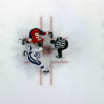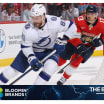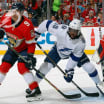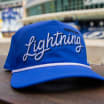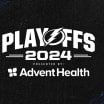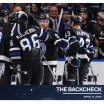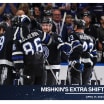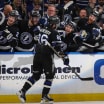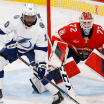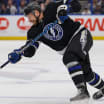The National Hockey League Draft was held virtually for the first time in its 58-year history Tuesday and Wednesday, each team setting up its war room in its local market and announcing its selections via video feed.
So, what did the new setup change for the Stanley Cup champion Tampa Bay Lightning, who made nine selections over the two-day affair, one more than they were scheduled to make entering the draft?
Well, as it turns out, not a whole lot.
How the Lightning drafted virtually
With the normal draft festivities unable to take place, the Bolts' brain trust set up at Firestick Grill inside Amalie Arena to make selections
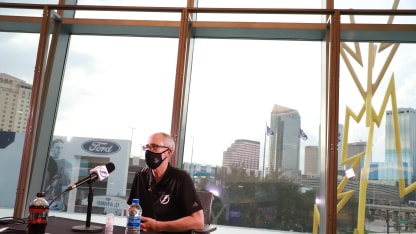
When hockey leagues around the world, including the NHL, shut down in early March due to the COVID-19 pandemic, the Lightning scouting staff had already conducted about 80 to 85 percent of its viewings of potential prospects according to Al Murray, Lightning assistant general manager, director of amateur scouting and the architect of the Bolts' draft classes since his arrival to the organization in August 2010.
Murray and his staff began assembling its draft list within a week after the NHL pause when it was fresh in everyone's mind. That list was tweaked in the months that followed, but the bulk of the work was done in March.
"It was definitely different going through the process of putting the list together, trying to do everything by either Zoom or conference call, tracking down the players for interviews by the same means, talking to teams," Murray told reporters at the conclusion of the 2020 NHL Draft. "You just lose so much of that face-to-face contact. You lose opportunities to see guys at the combine and put a body type and an athleticism to a face."
NHL Draft | Al Murray
That draft list is the template by which the Lightning decide which players they'll select, whether to trade up or down from a particular spot or explore other trade options. One of the ways this year's draft list was more difficult to compile than previous ones was the inability to connect with people in person, where a lot of the information that determines whether a prospect is worthy of selection can be gleaned. Seeing the prospect play in person as well as video from his season is certainly valuable, but to ascertain the true character of a player, something the Lightning place a premium on when drafting, in-person contact with the prospect as well as those around him plays a vital role.
"I know our guys put more time into this draft than ever before because so many things you can do while you're in the rink as far as meeting people and talking to players were unavailable after early March," Murray told radio play by play announcer Dave Mishkin and studio host Greg Linnelli during Thursday's Power Lunch show on Lightning Power Play. "So they have to do a lot of work on Zoom calls, a lot of work on phone calls, tracking down managers, coaches, education people with the various teams, billets in addition to talking to the players themselves. So, it was a lot more work for our guys. I thought they put in great effort, and we came up with a really strong list. We felt we got a really good group of prospects to add to the organization (Wednesday)."
Murray said this year's draft list, despite being limited somewhat with their ability to scout players and meet in person to determine best fits for the organization, was the largest he and his staff have ever put together.
"We've never had more than about 120 names on the list," Murray said. "This year we had about 150. And with that list, we've never gone, even with 120, beyond our 100th name, and even with 150 players this year that we liked, we still were getting players in around our top 100. We felt it was a real strong draft, but we thought we could make some real good picks and add some real good prospects to the organization."
The Lightning broke their draft list down into tiers, the first of which was 10 or so players, headlined by number one overall pick Alexis Lafreniere, who was selected by the New York Rangers. The second tier was another group of 10 or so players that were slightly behind the top tier.
"The way the draft was shaping up, there was somewhere between 20 to 25 guys that everybody knew were going to go in the first round, and then from that point on, it was kind of a shotgun blast of about 40 players that could have gone in almost any order depending on what teams like and behind that group was another group of 30 to 40 players," Murray said. "We felt without a first round pick, we knew we weren't going to get any of the top 20 or so players, but we were pretty comfortable that we were going to be able to get some really good players through the second, third and fourth round that we would have ranked very highly and very worthy of that designation."
Originally, the Lightning's first selection in the 2020 Draft was the last pick in the Second Round, number 62 overall. By the time the draft got to around pick 50, Murray and his team felt pretty good about their chances of getting one of their desired players because there were still four players remaining on the board who they had rated highly.
Two of those players came off the board in back-to-back selections, however, and suddenly the Lightning had a decision. Murray presented the information to Lightning general manager Julien BriseBois, explaining it might be beneficial to move up in order to ensure they'd be able to select one of those remaining highly-desired prospects before they were taken off the board.
BriseBois was able to negotiate a deal with Montreal, sending the Lightning's Second Round pick in 2021 and a Fourth Round selection in 2020 to the Canadiens in exchange for the 57th overall pick in 2020.
57th Overall Pick, Jack Finley
In that spot, the Lightning were able to select one of the two remaining highly-regarded prospects on their draft list, Jack Finley, a towering 6-foot-5 center from Spokane of the Western Hockey League.
When the Lightning selected again at No. 62 overall, they nabbed the second of the highly-rated prospects they had an eye on who was still available, taking Gage Goncalves, a 19-year-old center from Spokane of the WHL who has followed a similar career trajectory and has a work ethic that's reminiscent of current Lightning center Anthony Cirelli.
Goncalves said, as a prospect, the 2020 Draft was different because of the inability to experience the festivities in person. This year's draft would have been held at the Bell Centre in Montreal in front of a packed arena filled with prospects, their families, agents and fans. When their name is called, a drafted player gets a jersey from his new team and pictures taken with the hockey operations staff from that team at the front of the arena. Then he'll do interviews with the television stations broadcasting the draft before heading into the bowels of the arena for more pictures, interviews with local media and meeting different personnel within his new organization.
None of the draftees in the 2020 class got to take part in that experience.
"It would have been nice to go to Montreal and do the whole experience and everything, but this year I got to have a lot of my family over and my grandpa was able to stay home and watch it with us," Goncalves said. "He wasn't going to be able to travel. It was kind of a little blessing in disguise there."
Murray said the decision to move up and take Finley while also grabbing Goncalves was similar to the 2014 Draft when the Lightning moved up one spot from 80 to 79 in a trade with Minnesota to ensure they'd be able to select Brayden Point, the center who would become a cornerstone of the franchise, scoring a team record 14 goals in the 2020 playoffs to lead the Lightning to the Stanley Cup.
"We'd been trying to trade up 10 spots, then nine spots, then eight spots to get Brayden Point that year because he was the last guy on the list," Murray explained. "So now we had two players left in that category, Jack and Gage, and we talked to Julien about it and we said these guys are going to be going a little earlier than we thought but not where they shouldn't be going. So, Julien was able to make a trade, move up and we were able to get both those players."
Point slipped to the Third Round of the 2014 Draft mainly because he was a bit undersized and his skating wasn't at the elite level it is now. Murray said, in the past, the Lightning might have shied away from a player like Point because of a perceived weakness in skating. But now the Lightning have the development staff in place to be able to potentially overcome those shortcomings.
Of course, it's incumbent on the player too to have the drive to take the resources available to him and use them to make him a better player and more likely to stick in the NHL.
Point certainly has that drive. By the time he finished his junior career, he was starting to skate at an elite level and didn't need further development in the American Hockey League, instead skipping that level and going straight to the NHL.
BriseBois on the NHL Draft and Qualifying offers
"I used to be one of those people that thought if the guy couldn't skate and had an issue with skating, it was going to be a problem that was maybe not able to overcome," Murray said. "But (Lightning skating consultant) Barb Underhill has made a believer of me. And oftentimes if we're worried about a player's skating, we'll send clips of it to Barb or Barb will get on the internet and watch the player and she'll tell us. Certain things can be fixed, certain other things are going to be a real problem to fix. She and the development people have done a great job in being able to bring some of these guys along that I thought skating might be too big an issue for."
The Lightning did their drafting Wednesday from AMALIE Arena on the club level inside Firestick Grill. Their makeshift war room took up one half of Firestick. A table was set up in the middle where each member of the hockey operations staff could sit, much like they would on the arena floor during a typical in-person draft. Televisions were set up in front with live coverage of the draft. On another screen was a continuous Zoom call with members of the scouting staff.
Behind Murray as he announced each of his picks was a floor-to-ceiling window that looked out over Ford Thunder Alley, with the yellow Lightning sculpture and the Tampa skyline in full view, ensuring the Lightning would have the prettiest backdrop of any of the teams selecting at this year's draft.
BriseBois said he took a hands-off approach to the draft, letting Murray run the show, and getting involved when negotiations needed to be made for a potential trade, like the one that landed the Lightning Finley or the team's other draft-day maneuver when they unloaded the opening pick of the Fourth Round (94th overall) to Philadelphia for the Flyers' Fourth Round (116th overall) and Fifth Round (147th overall) selections.
"I would say luckily for me, Al Murray essentially runs the draft for us," BriseBois said. "He sets it up. He prepares the list with his team of amateur scouts who travel the world and this year did a lot more video work than in years past just because all the seasons came to a halt in March and we didn't get a chance to do a combine. We didn't get a chance to do in-person interviews at the combine as we normally would. But in terms of prep work, I knew we were ready a long time ago. We fine-tuned the list over the last couple days here since I was allowed to exit the (Edmonton) bubble and meet with Al, who was here in Tampa the last few days. Everyone had kind of the same conditions to get ready for the draft. I didn't feel we were at a disadvantage at all. I certainly felt ready every time a pick came up. We knew who we were going to select, and we were excited to select those players."
Murray said the draft ran smoothly despite all of the obstacles that had to be overcome due to COVID-19.
"Hopefully this is the last time we operate this way," Murray said. "If we ever do it remotely again, it'd be great to have all our staff together where we can have a chat and talk about things. But it is what it is. Hockey certainly survived and away we went."

